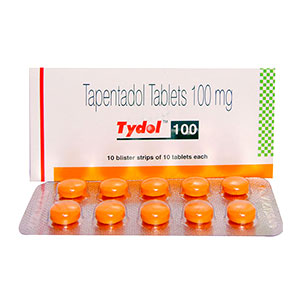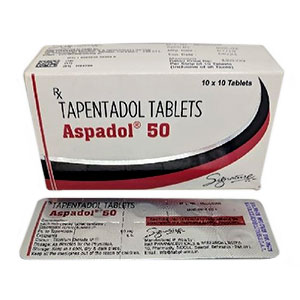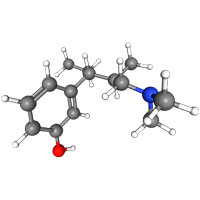The largest price comparison for medicines: the most popular pharmacies in comparison. Buy more than 200 medicines at low prices






Patent: Patent expired
Producer: Grunenthal GmbH
Dosage: 50mg, 100mg, 150mg, 200mg, 250mg
Dosage form: Extended release tablet
Unit of measurement: mg
Active ingredient: tapentadol
Application areas:
Severe pain, Acute pain
Drug class:
Onset of action:
Duration of action: 4-6 hours

Bioavailability: 0-50%
ATC-Code: N02AX06
Protein binding: ≥ 20%
Metabolism: No data available
Metabolites:
Half-life: 4 hours
Excretion: Urine
CAS number: 175591-09-0
PubChem-CID: 9838022
ChemSpider: 8013742
UNII: H8A007M585
KEGG: D06007
ChEMBL: ChEMBL1201776
ECHA-InfoCard: 100.131.247
Formula: C14H23NO
Molar mass: 221.344 g·mol−1
Tapentadol is a centrally acting analgesic that combines two mechanisms of action in one molecule, namely μ-opioid receptor agonism and norepinephrine reuptake inhibition.
μ-receptor agonists work by altering the emotional and sensory aspects of pain, inhibiting the transmission of pain to the spinal cord, and affecting activities in the parts of the brain responsible for pain perception. As a norepinephrine reuptake inhibitor, it increases the level of norepinephrine in the brain.
The effectiveness is comparable to morphine. However, tapentadol appears to be better tolerated, particularly in terms of digestive side effects such as vomiting, nausea and constipation.
The tablets tapentadol are taken orally in an initial dose of 50 mg twice a day. It is taken with water, 12 hours apart and independent of meals.
The dose should be set individually by the doctor, depending on the severity of the pain syndrome and the previous therapy.
Beware of the liver problems
Beware of kidney problems
Be careful with epilepsy
Caution when taking or using certain medicines
Drug abuse
Drug addiction
Hypersensitivity to the ingredients
Acute intoxication with alcohol, painkillers and sleeping pills or medication for certain mental illnesses
Intestinal paralysis
Asthma
Respiratory depression
Hypercapnia
Not safe
Alcohol consumption increases the side effects of medication
Do not apply a double dose if you have forgotten the previous application, but continue as before.
Serious side effects can occur after taking excessively high doses. If you experience severe side effects, seek medical help immediately.
There is a risk of serious interactions. Therefore, regular medical monitoring is required.
Headache
Dry mouth
Fatigue
Sleepiness
Food does not affect the effects of the drug.
Keep this medicine out of the sight and reach of children.
This medicinal product does not require special storage conditions.
How long does tapentadol work?


What is the maximum daily dose of tapentadol?


Is tapentadol a BTM?


How dangerous is tapentadol?


Can Tapentadol Cause Addiction?


Tapentadol is a centrally acting analgesic belonging to the group of opioid analgesics. It is used to treat moderate and severe pain that can only be adequately managed with opioid analgesics.
Tapentadol is classified as a prescription narcotic in Britain. In Britain, this opioid analgesic was launched in 2010 in the form of prolonged-release tablets. It will be available as an oral solution throughout Britain from 2014. It is also available as immediate-release tablets.
There are two reasons why tapentadol is remarkable. First, it has two synergistic mechanisms of action, meaning it binds to μ-opioid receptors in the body to block pain and inhibits norepinephrine reuptake from the synaptic cleft. Second, tapentadol is the first centrally acting synthetic analgesic.
The drug is used only for moderate or severe pain that can only be adequately managed with opioid analgesics.
Osteoarthritis, diabetic neuropathy and back pain are the ailments for which tapentadol can be prescribed. As a rule, it is not recommended for respiratory diseases such as asthma. It is also not suitable for patients with severe kidney or liver disease.
You can buy the painkiller Tapentadol under the trade name Palexia in 3 dosage forms. There are 50 mg, 100 mg, 150 mg, 200 mg and 250 mg prolonged release tablets, immediate release tablets and oral solution on the market.
Tell your doctor if you have the following symptoms:
Tell your doctor and pharmacist about all medicines you are taking (both prescription and over-the-counter medicines, natural remedies, and vitamins). Tapenpadol may interact with other medications.
This drug has the potential for addiction and abuse. This should be taken into account when prescribing a medicine containing tapentadol.
At high doses and in patients with hypersensitivity to agonists of the µ-opioid receptors, tapentadol can induce dose-dependent respiratory depression.
Tapentadol should not be prescribed to patients who are particularly sensitive to pathophysiological reactions.
This preparation can cause sphincter of Oddi dysfunction.
Tapentadol should be used with caution in patients with biliary tract disease, traumatic brain injury, brain tumor and acute pancreatitis.
Special caution is required in the case of adrenal insufficiency (e.g. in Addison's disease), alcoholic delirium, myxedema, toxic psychosis, hypothyroidism, as well as prostatic hypertrophy and urethral strictures.
Stopping tapentadol (Palexia, Nucynta) suddenly can develop withdrawal symptoms such as: B. Anxiety, excessive sweating, chills, pain, insomnia, nausea, tremors, diarrhea, piloerection and rarely hallucinations. To prevent withdrawal symptoms, the dose of the drug should be reduced gradually.
It should be noted that this preparation can cause a significant drop in blood pressure. Patients with hypovolemia or those taking tapentadol concomitantly with phenothiazine derivatives or anesthetics are particularly susceptible.
A life-threatening serotonin syndrome can develop if tapentadol is taken concomitantly with serotonergic drugs. These drugs are selective serotonin reuptake inhibitors, serotonin and norepinephrine reuptake inhibitors, tricyclic antidepressants, triptans, drugs that affect serotonergic transmission in the central nervous system (e.g., mirtazapine, trazodone, and tramadol tablets), and drugs that inhibit serotonin metabolism (e.g., MAO- inhibitors). Possible symptoms of serotonin syndrome include: confusion, restlessness, coma, tachycardia, fever, impaired motor coordination, nausea, vomiting and diarrhea.
Due to an increased risk of seizures, tapentadol should be used with caution in patients with a history of seizures or epilepsy.
In rare cases, some patients can experience serious and sometimes fatal side effects. Call your doctor or see a doctor straight away if you have any of the following signs or symptoms, which could cause serious side effects:

Palexia was prescribed by my doc for severe osteoarthritis. Here it is important to find the right dose. I take 150 mg tapendapol and I`m fine with it. Thank goodness the headache didn`t last long.
03.03.2021


Subscribe to our newsletter and get the latest updates and special offers!
Leave a comment
Thank you for sharing your experience!
Your experiences will be published soon!